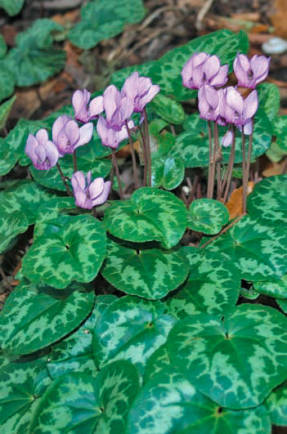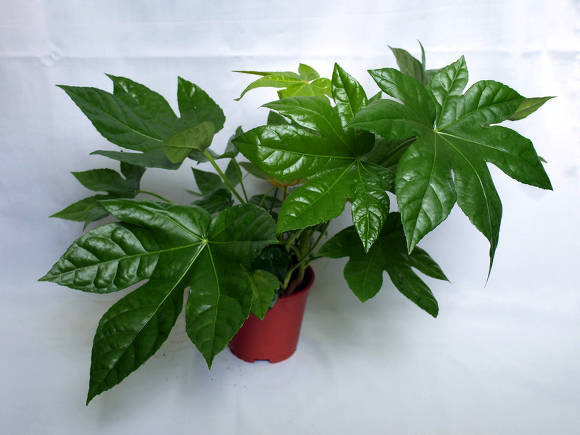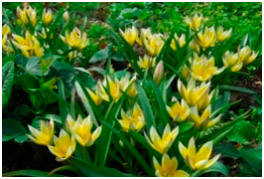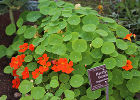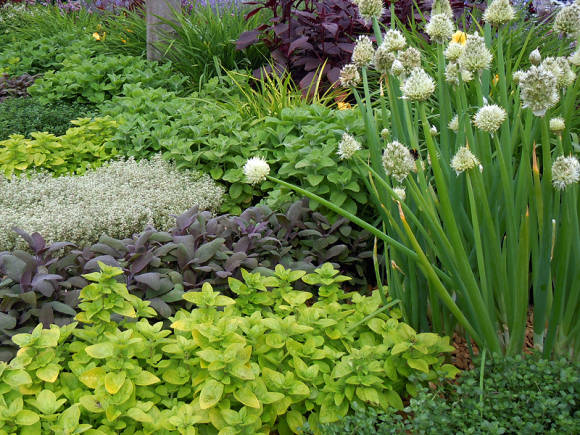
Our garden appeared 11 years ago together with a lonely blue spruce and forest junipers planted by the previous owners. Since my knowledge of plant growing was very minimal, and apart from roses, peonies and a few perennials, I did not particularly understand ornamental plants, in my garden I started everything from scratch.
The work is in full swing!
Having moved there in the spring, at the beginning of the season, we started by clearing the site of debris. Since the plot is large - 20 acres - and was almost empty, there was nowhere to hide from the sun. They began to plant it with everything that grew in the nearest forests - at the edges of the site there were spruce and pine trees from the forest, and closer to the house - forest junipers, without even thinking that over time they would grow strongly. There was a desire to shade the garden and hide from prying eyes.
Over time, I became convinced that this was done correctly. We have very strong winds, and conifers perfectly protect the garden from them.

Five years later, the plantings began to grow, and I began to pinch forest pines. Of course, they are far from niwaki (Japanese style of tree formation), but the "koloboks" of them turned out to be even very cute and compact.
Then came the passion for rare varietal conifers with different colors of needles, as well as hydrangeas of all types and varieties. With our scanty sandy soil, she also had to deal with it. Then I began to experiment, learning that rhododendrons, azaleas and magnolias get along well with conifers and hydrangeas. More and more I wanted to plant plants from the risk group, not for our climatic zone. I learned from my mistakes, with constant transplants and searching for something new.
How they painted a picture of the garden
Initially, there was no definite plan when laying the garden, especially since we continued what had already been started by other owners. I had to combine the orchard with the ornamental one, since it was too late to replant, and it is a pity to lose the existing fruit plants. It turned out even more beautiful when an apple tree and a pear bloom around the conifers and ornamental-deciduous plants in spring.
 |  |
This tall hedge of thuja Smaragd. Plants are densely planted to each other, over time they will merge and become one whole. The hedge is designed to hide the recreation area with a gazebo from prying eyes, separates the plot from neighbors, and also protects the garden from the wind from the north in winter. Ornamental flowering shrubs and perennials are located around the gazebo and in the nearest visibility zone from it.
Many different recreation areas have appeared in our garden: for active children behind the house there is a playground with a trampoline and a pool built by my husband and me; for soothing and tea drinking - a gazebo with ponds on both sides (one pond with a small waterfall, the other with fish and blooming nymphs); in the shady zone between the houses there is a swing, where in hot weather you can hide from the heat with a book.
There is also a forest zone where the very spruces and pines from the forest grow - the very first inhabitants of our garden, as well as a fruit zone. It is located behind the house, where children and guests can enjoy sweets. There grow: remontant raspberries, ezhemalina, currants, yoshta, honeysuckle, gooseberries, felt cherries, apple trees and other fruit and berry crops.
I wanted my garden to remain decorative from early spring to late autumn, when everything fades. This was achieved by combining different colors and shapes. Having seen many beautiful gardens, I learned from others, tried to create a garden of contrasts, combining colorful shrubs with conifers. Bright accents of the garden are sumac of the Tiger Eye variety (yellow all summer, but wintering every year with shelter), Hakuro Nishike's willow (decorative all summer), Flamingo and Royal Red maples, Diabolo bubble, barberries, spireas, various varieties of viburnum, hydrangeas.

In the spring, varietal conifers delight with their multi-colored shoots, then the flowering of azaleas, rhododendrons and magnolias begins, later they are joined by large-leaved and panicle hydrangeas, roses, perennials.
In the garden in summer, the queen of the garden is hydrangeas with their huge inflorescences: paniculate of various varieties and large-leaved. They also get along well with conifers and look much more beautiful against their background than alone.
I also love herbs and grains, which soothe, add mystery, naturalness and pacification to the garden.
 |  |
Coniferous crops occupy the most honorable place in my garden, they are leaders in any composition. The composition, "A Hill with a Deer" (you will find it in all its glory just below), was specially suited for the recumbent juniper Nana, who effectively settled there, sliding down a hill.
Autumn is a special time when all deciduous shrubs enter the scene, arranging such a riot of colors that even in summer, when everything is in bloom, you cannot see this.
Winter is the time of my favorite conifers, when the geometry of the garden is revealed. Sheared thuja balls, pyramidal emeralds, spiral sheared thujas, weeping willows and larch trees on the trunk transform the garden and make it attractive even in winter.
Ophir, Aureya, Winter Gold and others change their color to yellow.
The winding branches of Kantor's hazel are beautiful, the sod of Siberia is red. They are especially beautiful against the backdrop of white snow.

Each plant in the garden enhances the beauty of the other plant as they are different in color and shape. While the conifers are slowly growing, I fill up empty spaces with bright geykhera, hosts, low-growing barberries and spireas, which look great against the background of conifers. Of course, I want to see roses nearby, but they do not get along well with them according to the type of soil, since they do not like an acidic environment. But I plant ground covers, they are less whimsical in such a neighborhood.
In the garden of a fairy tale
Since we have many children (three daughters and two sons), I wanted to bring a little fairy tale to the garden. Given their small age at that time, I tried to add a little fabulousness and mystery to each composition: winding paths hiding something around the bend, a slide with a deer and a fawn, a bear with a bear cub, a mill near the pond, which was my very first building, then went bird feeders, where feathered guests from the forest feast on all winter, and in summer they help to fight garden pests, a bridge over a dry stream, ponds with nymphs and fish wintering in them, and the gazebo, which I made in the Chinese style, unites everything, converted with the help of her husband from a simple rag tent.
 |  |
In our garden, my husband and I do everything ourselves: he works with metal, and I work with wood and stone. Over time, all these small compositions merged together into one whole picture. And when it was necessary to come up with a name for the garden, the whole family thought. We stopped at one - "In the garden by the fairy tale", because even growing up, we continue to believe in miracles.

About paths, or Everything to the garden!
In our garden there are many paths leading to different corners, so sometimes there is a desire to put up a sign at a fork with the inscriptions: if you go to the right, you will find happiness, if you go to the left, you will lose, if you go straight, you will find yourself in a fairy tale, but you cannot look back (this, of course, joke!).
 |  |
The paths were originally planned: the main ones - of mosaic stone on cement, the secondary ones - of limestone - just on the sand (pictured), so that they could be shifted if desired.
In general, there is a lot of stone in the garden in various compositions, they took it every year from different places: they rested in the south - they collected it on a mountain river, then laid out paths with it on cement and fences, and so little by little every year.
The husband worked for a concrete mixer, as this is the most difficult process for women’s hands. It is easier to lay out the slabs - I chose turf, making the trench the width of the desired path, poured some sand and small rubble, spilled it, tamped it with a homemade device from a bar and a board, and then how to collect puzzles with children, and the flagstone is laid out. And to get rid of the grass in the seams for the first 2 years, I spilled them with Roundup. Later, moss begins to grow and there is almost no grass.
Do-it-yourself everything
A fence along the thujas and hydrangeas was made by me in order to separate the pedestrian zone leading to the gate from the central part of the garden.
 |  |
First, I cut out the formwork from old plywood 10 mm thick with a jigsaw - along the width and height of the section, further along the edges I made an imitation of pillars from a 10-centimeter block house, folded together, tightened with self-tapping screws, dug into the ground and filled with cement mortar inside. On top of the pillars, she installed simple Chinese lanterns with solar panels.
Between the pillars, she put the formwork on both sides, fixing it with self-tapping screws to the edge of the pillars so that the cement would not leak out when pouring. To strengthen the structure, before pouring the cement, she drove metal pipes and fittings into the ground inside the formwork.
Each section takes 2 days. Then she removed the formwork, rearranged it and continued working. To round off the formwork at the end of the structure (you see, the fence forms a turn), I used old cellular polycarbonate, it bends well to any shape.
When a few sections were ready, I began to glue the fence with mosaic stone using Eunice's tile adhesive. To protect against water ingress in winter and cracking, the seams between the stones were well coated.
To revive the cold stone, a flower pot was inserted into the formwork before pouring the cement mortar, fixing it with self-tapping screws to the formwork. When the cement hardened, she unscrewed all the screws and rearranged the formwork.
The fence around the gazebo was made according to the same principle, only there, for decoration, I used tree roots brought from the south and polished by the sea.
 |  |
The gazebo is not on its own!
We have been creating this composition with a bridge and a pond next to the gazebo for 5 years, constantly changing something, until we achieved the desired result.
Initially, a corner bathtub was dug in here, painted with black paint, which peeled off - the paint did not stick to the plastic. The walkway is made from the remains of a floorboard left from the floor in a rag tent and sprinkled with fine gravel.
When the fabric of the tent was all torn, we converted the tent into a stationary gazebo, made a two-tiered roof and covered it with metal tiles.
To give the gazebo lightness and good visibility, I made frames from thin monolithic polycarbonate.
Then she covered the inside of the bathtub with construction mesh and laid out a mosaic stone, making a small waterfall on top.
She added a stone fence to the already standing pillars made of timber, finishing it with mosaic stone. So there was a composition with a pond with a waterfall and a bridge leading to it, which my husband welded from separate forged parts. I made the pedestrian part of the bridge myself from a bar.

Mini pond out of the blue
Children suggested the idea of creating this pond. When they were small, there was a sandbox on this place, formed after the construction of the pool, and they loved to build castles there, dig holes, constantly flooding everything with water, and launch boats. And in the morning, in bewilderment, they discovered that the water was gone. Then they grew up and began to understand that in order for the water to hold, a plastic wrap is needed. But she was torn again and ... the water was leaving.
The children grew up, other interests and hobbies appeared, and they abandoned the idea of the pond. And I still remember their unfulfilled dream. Of course, we have so many small reservoirs on the site, but a gas pipe runs here and nothing can be built or planted large. So I decided to continue what the children had begun - to make a small pond for aquatic plants.

The bottom of the pond was covered with geotextiles, then a membrane for reservoirs of 0.1 mm, again geotextiles, on top - gravel crushed stone 0.2-0.5 mm, mosaic and large stone with snags to give natural scenery and naturalness.
Near the pond, gray fescue, badan, horizontal cotoneaster, sheared pine Aurea, pseudosibold maple, Chinese miscanthus, western thuja Bowling Ball, falaris are perfectly located.
You can never give up your dream, and when the children grow up, they will understand that even after years it is possible to implement their plans, and any idea can be continued!
 |  |
P.S. A garden is a constant movement and creativity, where there are no complete pictures, something always changes, and where time makes its own changes, sometimes even beyond our control.

